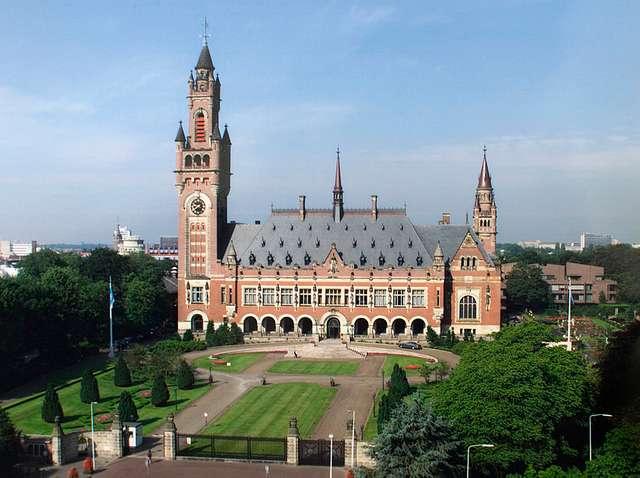PROTECT YOUR DNA WITH QUANTUM TECHNOLOGY
Orgo-Life the new way to the future Advertising by AdpathwayEarly this year, Canada pledged CA$15 million toward climate adaptation projects in Nepal, Bhutan and Bangladesh. It has teamed up with the International Center for Integrated Mountain Development (ICIMOD), a Nepal-based NGO. This contribution is a clear instance of climate adaptation finance—that is, funding toward projects that will help reduce vulnerability to climate change. The project, which will run over five years, is composed of three parts that will address separate but related issues: (1) water scarcity, (2) the resiliency of women and Indigenous communities and (3) the upscaling and spread of similar adaptation projects globally.
 The Himalayas in Nepal, part of the region where ICIMOD operates. Credit: “Nepal Himalayan Adventure 2012” by Frontierofficial, CC BY 2.0
The Himalayas in Nepal, part of the region where ICIMOD operates. Credit: “Nepal Himalayan Adventure 2012” by Frontierofficial, CC BY 2.0The Hindu Kush Himalayan region includes eight countries (Afghanistan, Pakistan, Bhutan, Nepal, China, India, Bangladesh and Myanmar). Of the 270 million people in these countries who reside in mountainous areas, one-third are already food insecure. ICIMOD seeks to improve their livelihoods by promoting what they term greener, more inclusive and climate resilient development. Canada’s $15 million pledge will facilitate ICIMOD’s goals, particularly for the region’s most vulnerable populations: women and Indigenous Peoples.
“Women have to take care of household matters, their elderly family and their children during extreme events. They are more vulnerable to climate change because of all these burdens,” Abid Hussain, a senior economist and food systems specialist for ICIMOD, told GlacierHub in an interview. “Indigenous people are less recognized in the policy process and in their access to institutional services like credit, technology and scientific knowledge. This specific project will actually focus on the empowerment of women and Indigenous communities.”
Water access is the first issue the project plans to address in both the long- and short-term. Hussain explained that as glaciers continue to melt, the availability of water in the region is expected to peak around 2050 and then decline afterward. Many springs in the region are already drying up due to changes in precipitation and temperature. The construction of buildings in the area has also affected the region’s underground hydrology.
“There are 8 million springs in the Hindu Kush Himalayan region and 40-45% of springs are facing reduced water flow or are completely dry,” said Hussain. ICIMOD has developed techniques that help communities and local governments revive their springs to mitigate water scarcity right now. They have also developed plans to help high altitude farms access spring water more easily, as these farms currently rely on glacier-fed irrigation systems that will not last in the long term.
“Springs and rivers are flowing in the valleys. For agriculture fields on terraces, sometimes they are a bit higher in altitude,” said Hussain. “What we will do is use renewable energy to pump that revived spring water to irrigate their agriculture field. We call it an ‘integrated solution’ for agriculture.”
 Agriculture terraces in Nepal are set at high elevations, creating irrigation challenges. Credit: “Himalayan foothills in Nepal” by National Snow and Ice Data Center, CC BY 2.0
Agriculture terraces in Nepal are set at high elevations, creating irrigation challenges. Credit: “Himalayan foothills in Nepal” by National Snow and Ice Data Center, CC BY 2.0The second step of the project is to build the adaptive capacity of women and Indigenous communities by granting them greater access to markets and providing financial and business education.
“We will also train them, developing their agriculture farms into more business-oriented managements,” said Hussain. These programs will teach them how to best use water resources and revive the springs. This education and training will improve resilience by supporting agriculture and increasing income.
The third and final challenge of the project is upscaling so that its practices can help other regions. The project aims to test these integrated solutions for future replication elsewhere. The impacts of funding a climate adaptation project of this kind could be widespread, particularly given the historical challenges climate finance has faced.
“The biggest climate financing gaps are in areas where risk is perceived as high or where returns are uncertain, such as projects in emerging and developing economies, investments in adaptation, first-of-a-kind technologies and so on,” Lisa Sachs, the director of the Columbia Center on Sustainable Investment, which is part of the Columbia Climate School, told GlacierHub in an interview.
Developing countries that are more vulnerable to climate change threats are reliant on wealthier states to provide them with climate adaptation funds. However, securing these funds has been historically difficult, as Paul DeNoon, a senior advisor to the Columbia Climate School and financial market expert, told GlacierHub.
“Most emerging or developing economies have underdeveloped domestic capital markets and obviously low levels of savings. Thus, they are very dependent on foreign capital flows,” said DeNoon. “These countries have low credit ratings and either the borrower or lender must assume the current risk, which historically has been quite high. Credit and currency risk is a major impediment to climate finance.”
At the most recent Conference of the Parties, COP29, a New Collective Quantified Goal (NCQG) was established. The purpose of the NCQG is to set a financial goal for supporting climate action (both mitigation and adaptation projects) in developing countries. A $1.3 trillion dollar target was set for climate projects by 2035. However, both Sachs and DeNoon felt that the NCQG needs improvement.
“The NCQG from COP29 confirmed one basic and uncontroversial point: we need to scale climate finance to the trillions, and much of the financing will have to come from private capital markets,” said Sachs. “Beyond that, it delivered very little and was a genuine disappointment. It did not provide clarity on what needs to be financed or how, on priorities or barriers, or on the actual mechanics of mobilizing or deploying capital.”
While NCQG is lacking in both the necessary funds and the specifics for their use, the Canadian initiative is an example of climate adaptation finance in the face of these challenges. ICIMOD’s adaptation projects for climate resilience, directed to the region’s most vulnerable populations, demonstrate the possibilities that adaptation finance can have in the future.























 English (US) ·
English (US) ·  French (CA) ·
French (CA) ·